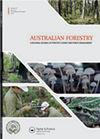Insect pests of timber-in-service: an Australian review
IF 0.9
4区 农林科学
Q3 FORESTRY
引用次数: 3
Abstract
ABSTRACT ‘Timber-in-service’ consists of tree components prepared for use in building and carpentry and other wooden infrastructure such as bridges, pylons and power poles. About 70% of timber used in Australia goes into building and construction and 15–20% goes into furniture, and 50 000 electricity poles are produced annually. Timber-in-service pests are a threat to such material throughout its service life. In this review, we identify native and non-native insects associated with timber-in-service in Australia and their impacts and current management. Border and post-biosecurity interception data of insects associated with wood and wood products are analysed to assess future risks, and key biosecurity threats (i.e. exotic timber-in-service pests) are identified. We review current biosecurity systems and processes related to the mitigation of potential threats to timber-in-service and provide examples of how detections of exotic timber-in-service pests are managed in Australia. We conclude with recommendations on how to improve biosecurity and management of timber-in-service pests.在役木材的害虫:澳大利亚综述
“现役木材”包括用于建筑、木工和其他木制基础设施(如桥梁、塔架和电线杆)的树木部件。在澳大利亚,大约70%的木材用于建筑和建筑,15-20%用于家具,每年生产5万个电线杆。在役木材害虫对这种材料的整个使用寿命都是一种威胁。本文综述了与澳大利亚现役木材有关的本地和非本地昆虫及其影响和管理现状。分析了与木材和木制品有关的昆虫的边境和生物安全后截获数据,以评估未来的风险,并确定了主要的生物安全威胁(即外来木材使用害虫)。我们回顾了当前与减轻现役木材潜在威胁有关的生物安全系统和流程,并提供了澳大利亚如何检测外来木材害虫的例子。最后,就如何加强木材害虫的生物安全和管理提出了建议。
本文章由计算机程序翻译,如有差异,请以英文原文为准。
求助全文
约1分钟内获得全文
求助全文
来源期刊

Australian Forestry
FORESTRY-
CiteScore
3.70
自引率
4.80%
发文量
15
审稿时长
>12 weeks
期刊介绍:
Australian Forestry is published by Taylor & Francis for the Institute of Foresters of Australia (IFA) for scientific, technical, and professional communication relating to forestry in the Asia Pacific.
 求助内容:
求助内容: 应助结果提醒方式:
应助结果提醒方式:


